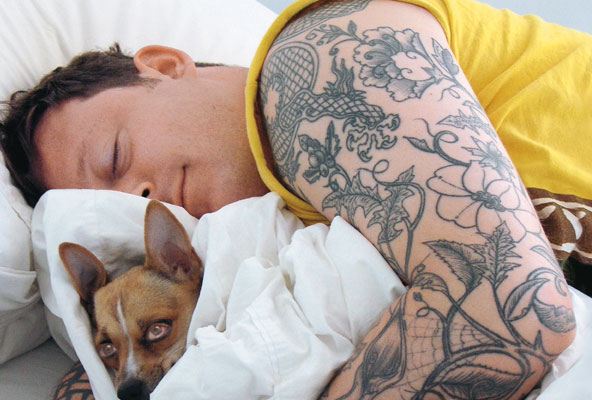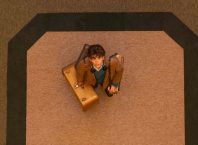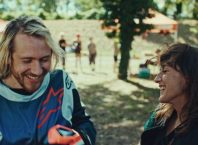
What is one to make of Urs Fischer?. There’s his physical presence, for one thing: his bulk, the mass of tattoos criss-crossing his arms and neck, his scruffy appearance. But the easy presumptions that arise from this are immediately contradicted by his comportment – soft spoken and courteous, nimble on his feet and deft with his hands, a constantly moving bundle of kinetic energy.
And then there’s the art: his signature pieces are huge affairs, like Untitled (Lamp/Bear), a bronze sculpture of a teddy bear juxtaposed with a table lamp. It celebrates the keepsakes that define a child’s early life, and stands 7 metres high. Or Jet Set Lady, a metal tree he erected in the Institutio dei Ciechi in Milan, 9 metres high and with 2000 of his illustrations and sketches hanging from its branches. These contrast with delicate, detailed sculptures; a rabbit smoking, a mouse playing the violin, neither more than a handspan in height. He has created huge abstract sculptures, based on clay models crafted by hand; he has displayed hyperrealistic photographs, the detail emphasized until the point that one feels almost able to step across into the shot. He’s not so much a man of contradictions, rather a man who defies categorization. The problem doesn’t lie with trying to define him; rather, it’s simply keeping up with him that’s a task in itself.
In his eponymous documentary of the artist Urs Fischer, Swiss documentary maker Iwan Schumacher takes an understandably understated approach to capturing its subject, following him at a remove as the artist prepares for his first major exhibition in the United States – a one man show at New York’s New Museum. As Schumacher explained whilst in Tel Aviv recently – a guest of the EPOS International Art Film Festival, which took place in Tel Aviv at the beginning of the month – he finds his countryman beguiling. “I was just amazed at his physical presence, the way he walks, his gestures,” Schumacher says. “He reminded me a bit of an actor, the way they used to make them but don’t any more.” Fischer seems to have this effect on people around him. In the 90 minute film, we see him constantly accompanied by assistants and helpers, all eager to do his bidding. Something of the man’s boyish charm comes across very strongly in the film. Even when he turns plans for his exhibition upside down, revising the exhibits and extending the length of the accompanying catalogue significantly – and without warning – all one can do is smile. It’s the way that he is.
Filmed over six years, Urs Fischer is a patient affair, shaping an interesting portrait of the artist at work. Schumacher – who has made several other documentaries featuring Swiss artists – says that he knew that he wanted to make a film about Fischer after seeing an exhibition his work in Zurich. Fischer’s work struck him in much the same way as the artist. “You find the same physical quality in his work, and I was both intrigued and interested.” Working alone, Schumacher filmed Fischer as he worked on his next piece – the lamp bear. At some point, Fischer agreed to cooperate on the making of a formal documentary: “He once mentioned that he liked the way I filmed, alone” Schumacher says. Both were clear that the film was about the work and not the personality. “I was absolutely free, no restrictions. But it was clear to both of us that it was strictly to do with his art, nothing peripheral.”
Still, as the camera follows Fischer from Australia to China to Manhattan, it is inevitable that something of the person behind the art emerges. Fischer’s art seems underpinned by a wry, at times even whimsical sense of humour. Many of the works featured seemed shaped by impulse, rather than calculation. Little time is spent on ex poste facto interpretation, because Fischer’s attention has already moved on. But then, occasionally, he permits a little illumination into the creative process. “Fear is a motor,” Fischer says at one point. Then he laughs off the momentary self analysis. But it is a telling admission, all the more poignant because it wasn’t teased or tricked out of the subject of the film.
“If you don’t have a certain closeness to the person or to his work, then (documentary) won’t work,” Schumacher opines, thoughtfully. But surely this closeness comes at the risk of losing one’s objectivity? “Not at all,” he replies. His approach to filming tends towards the maximalist, he explains “It shouldn’t be that way,” he remarks wryly on the 6 years that it took to put Urs Fischer together, “but…”. Afterwards his long time editor Anja Bombelli strips things down to manageable proportions. “She is never part of the shooting, so when she sees the material she never knows how much it cost, in terms of money or blood or whatever,” Schumacher laughs.
One senses that Schumacher is more interested in observation than in interpretation, and I wonder whether he has ever thought of turning his documentary method onto other subjects outside the art world. It turns out that he has, with the most beguiling of subjects – ordinary people.
“A friend had a radio talk show, where people could call up and discuss what they wanted with him. It was very popular and had a wonderful quality because it was open, unscripted.” Schumacher wondered if this essence could be translated to a different setting; they approached strangers on the street and asked if they would tell their life stories. “If they agreed, we went into a restaurant, a place we had prepared with three small cameras and we did the interview over 40 minutes.”
40 minutes may not seem like enough time for one to tell their life story. But invariably, Schumacher explains, it was more than enough. “By the end, they were exhausted. And they had told their story.” A little light editing later, the interview was ready for television. The series ran for three years and more than a hundred interviews. “The fantastic thing was that you never knew what you were going to get,” Schumacher enthuses.
Rather like Fischer, one can’t help thinking. And it’s this quality, the sense of the unknown, that runs through the middle of Urs Fischer.





